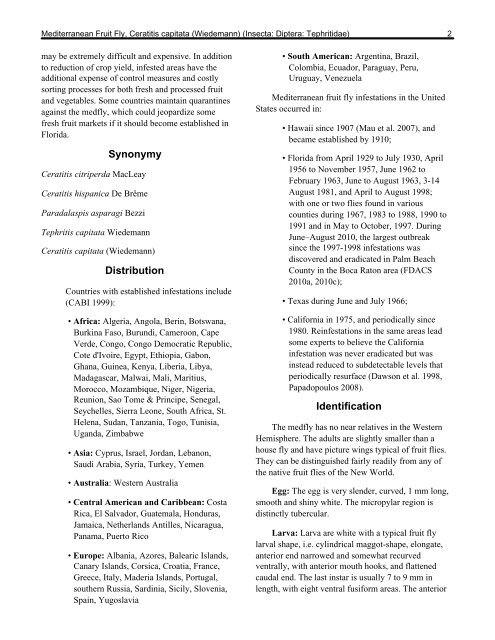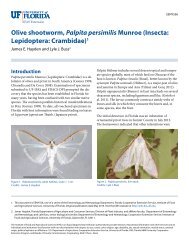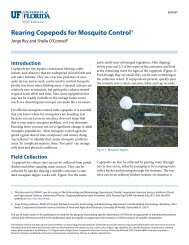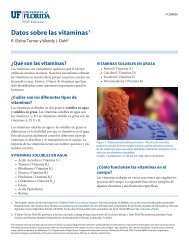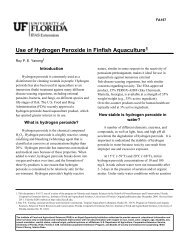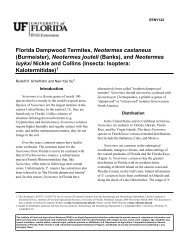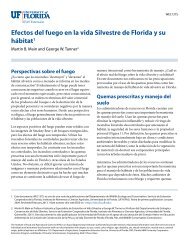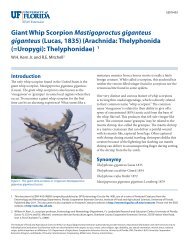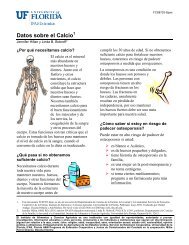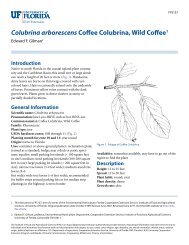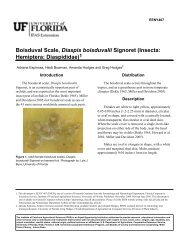Mediterranean Fruit Fly, Ceratitis capitata (Wiedemann) - EDIS ...
Mediterranean Fruit Fly, Ceratitis capitata (Wiedemann) - EDIS ...
Mediterranean Fruit Fly, Ceratitis capitata (Wiedemann) - EDIS ...
You also want an ePaper? Increase the reach of your titles
YUMPU automatically turns print PDFs into web optimized ePapers that Google loves.
<strong>Mediterranean</strong> <strong>Fruit</strong> <strong>Fly</strong>, <strong>Ceratitis</strong> <strong>capitata</strong> (<strong>Wiedemann</strong>) (Insecta: Diptera: Tephritidae) 2<br />
may be extremely difficult and expensive. In addition<br />
to reduction of crop yield, infested areas have the<br />
additional expense of control measures and costly<br />
sorting processes for both fresh and processed fruit<br />
and vegetables. Some countries maintain quarantines<br />
against the medfly, which could jeopardize some<br />
fresh fruit markets if it should become established in<br />
Florida.<br />
Synonymy<br />
<strong>Ceratitis</strong> citriperda MacLeay<br />
<strong>Ceratitis</strong> hispanica De Brême<br />
Paradalaspis asparagi Bezzi<br />
Tephritis <strong>capitata</strong> <strong>Wiedemann</strong><br />
<strong>Ceratitis</strong> <strong>capitata</strong> (<strong>Wiedemann</strong>)<br />
Distribution<br />
Countries with established infestations include<br />
(CABI 1999):<br />
• Africa: Algeria, Angola, Berin, Botswana,<br />
Burkina Faso, Burundi, Cameroon, Cape<br />
Verde, Congo, Congo Democratic Republic,<br />
Cote d'Ivoire, Egypt, Ethiopia, Gabon,<br />
Ghana, Guinea, Kenya, Liberia, Libya,<br />
Madagascar, Malwai, Mali, Maritius,<br />
Morocco, Mozambique, Niger, Nigeria,<br />
Reunion, Sao Tome & Principe, Senegal,<br />
Seychelles, Sierra Leone, South Africa, St.<br />
Helena, Sudan, Tanzania, Togo, Tunisia,<br />
Uganda, Zimbabwe<br />
• Asia: Cyprus, Israel, Jordan, Lebanon,<br />
Saudi Arabia, Syria, Turkey, Yemen<br />
• Australia: Western Australia<br />
• Central American and Caribbean: Costa<br />
Rica, El Salvador, Guatemala, Honduras,<br />
Jamaica, Netherlands Antilles, Nicaragua,<br />
Panama, Puerto Rico<br />
• Europe: Albania, Azores, Balearic Islands,<br />
Canary Islands, Corsica, Croatia, France,<br />
Greece, Italy, Maderia Islands, Portugal,<br />
southern Russia, Sardinia, Sicily, Slovenia,<br />
Spain, Yugoslavia<br />
• South American: Argentina, Brazil,<br />
Colombia, Ecuador, Paraguay, Peru,<br />
Uruguay, Venezuela<br />
<strong>Mediterranean</strong> fruit fly infestations in the United<br />
States occurred in:<br />
• Hawaii since 1907 (Mau et al. 2007), and<br />
became established by 1910;<br />
• Florida from April 1929 to July 1930, April<br />
1956 to November 1957, June 1962 to<br />
February 1963, June to August 1963, 3-14<br />
August 1981, and April to August 1998;<br />
with one or two flies found in various<br />
counties during 1967, 1983 to 1988, 1990 to<br />
1991 and in May to October, 1997. During<br />
June–August 2010, the largest outbreak<br />
since the 1997-1998 infestations was<br />
discovered and eradicated in Palm Beach<br />
County in the Boca Raton area (FDACS<br />
2010a, 2010c);<br />
• Texas during June and July 1966;<br />
• California in 1975, and periodically since<br />
1980. Reinfestations in the same areas lead<br />
some experts to believe the California<br />
infestation was never eradicated but was<br />
instead reduced to subdetectable levels that<br />
periodically resurface (Dawson et al. 1998,<br />
Papadopoulos 2008).<br />
Identification<br />
The medfly has no near relatives in the Western<br />
Hemisphere. The adults are slightly smaller than a<br />
house fly and have picture wings typical of fruit flies.<br />
They can be distinguished fairly readily from any of<br />
the native fruit flies of the New World.<br />
Egg: The egg is very slender, curved, 1 mm long,<br />
smooth and shiny white. The micropylar region is<br />
distinctly tubercular.<br />
Larva: Larva are white with a typical fruit fly<br />
larval shape, i.e. cylindrical maggot-shape, elongate,<br />
anterior end narrowed and somewhat recurved<br />
ventrally, with anterior mouth hooks, and flattened<br />
caudal end. The last instar is usually 7 to 9 mm in<br />
length, with eight ventral fusiform areas. The anterior


